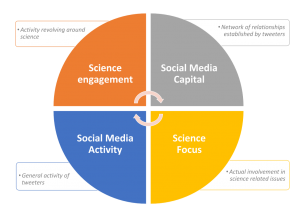Adrián A. Díaz-Faes analyses four dimensions of twitter metrics around science in a quantitative study.
‘Altmetrics,’ and more specifically, ‘social media metrics’ are increasingly deemed valuable indicators to gauge the dissemination and reception of research outputs beyond academic circles, but their potential could be much greater. To this point, these kinds of metrics were confined to counting the use and visibility of research publications on social media (e.g. tweets and Facebook counts, Mendeley readers, etc.).
My co-authors and I wondered what might happen if we shifted our focus from counting publications to understanding social media users around those publications. By creating this shift in focus we believed that we could measure the overall user activity on social media (e.g. number of likes, overall tweeting), as well as their specific interactions with research publications (e.g. number of tweets given to papers). This shift implies moving from the mere counting of social media events around research entities (i.e. scholarly outputs, researchers, institutions) to the understanding of the processes of interaction and circulation of scientific knowledge across broader online communities (i.e. tweeters, Facebook users, online reference manager users).
Among the myriads of social media platforms, Twitter stands out as it is widely used by the general public and researchers alike and has been shown (Thelwall et al., 2013) to contain the largest portion of the altmetric activity currently recorded by platforms such as PlumX and Altmetric.com. Previous research has disclosed scarce original content and engagement with research publications on Twitter (Robinson-García et al., 2017). In other words, “Twitter is less about what people tweet rather how they are connected” (Haustein, 2018). This supports the shifting in focus on mere accounts of events, to the interactions between online communities.
Although some studies have examined specific features of users’ behaviour within social media platforms (see Kwak et al. 2010), no study has suggested a typology of social media users based on both the overall user’s behaviour on Twitter as well as their specific interaction with scholarly objects. Before coming up with typologies of social media users around science, the dimensions of activity needed to characterise them had be flushed out. This was the aim of our paper.
We collected the Twitter activity of users with at least one tweet linking to a publication between 2011 and 2017 as covered by Altmetric.com. The dataset is comprised of over 1.3 million unique users, accounting for over 14 million tweets to scientific publications. We computed a number of metrics to characterize the behaviour of users on Twitter. Our data analysis revealed that activity around science on Twitter can be summarized into four latent dimensions.

- Science Engagement reflects to what extent sharing science-related material characterizes users’ Twitter activity. Here metrics such as the number of (re)tweets or hashtags are included.
- Science Focus mirrors tweeters involvement in science-related issues. Here metrics such as share of tweets to papers and the time between the publication of the paper and the tweet of the tweeter gain more relevance. Note that ‘Science Engagement’ may be understood as the quantitative side of engagement by users in science, whereas ‘Science Focus’ provides a much more nuanced insight that accounts for the overall tweeters involvement in science-related issues.
- Social Media Activity refers to what users share and to which issues are of a greater interest.
- Social Media Capital mirrors the user’s influence and centrality within the social media realm.
These four dimensions provide a benchmarking for comparative studies. Case studies and mapping may be performed for comparing users that show similar patterns on Twitter. Two users who are actually behaving similarly on Twitter may show different followers’ profiles and, therefore, have impact on very different communities. In addition, drawing on user’s profile descriptions we were able to build a terms map for the four dimensions that allowed us to outline the type of users that stand out in each dimension (random sample of profile descriptions from 200,000 Twitter accounts). We found four clearly defined communities of tweeters:
- Personal description: tweeters who discuss their private life and are highly active. Typical words: ‘mother’, ‘lover’, ‘love’, ‘life’, ‘fan’, ‘husband’, ‘soul’.
- Opinions and own position: users who describe themselves as opinion holders and show a certain degree of engagement and activity. Few words concentrate most of occurrences: ‘view’, ‘opinion’, ‘tweet’, ‘endorsement’ and ‘mine’.
- Academic role: tweeters who belong to the academia and are notable for their high science focus and engagement. It includes words such as ‘university’, ‘department’, ‘researcher’, ‘development’, ‘director’, ‘lecturer’ or ‘PhD student’.
- Business and practice role: users who refer to their professional role and show a more balanced pattern of use and relatively high social media capital. Typical words include: ‘organization’, ‘business’, ‘community’, ‘practice’, ‘service’, ‘client’ or ‘solution’.
All in all, the findings presented in the paper will help pave the way to the further unraveling of the mechanisms by which academic, and especially, non-academic actors interact with scientific publications and research entities. This approach meets the increasing demands by scholars for moving beyond the hegemonic evaluation model based on citations and productivity toward analysing the societal impact of research. However, there is still a long way ahead for understanding the potential use of social media metrics as a reasonable proxy of societal impact.


